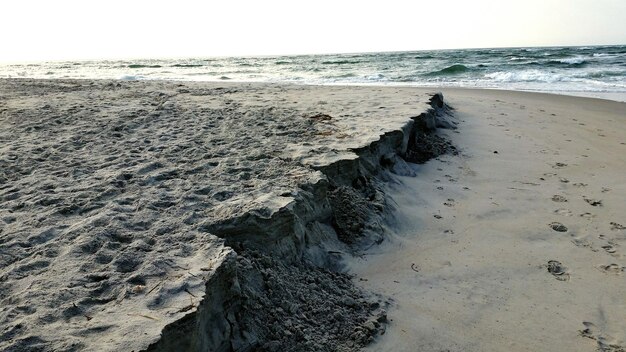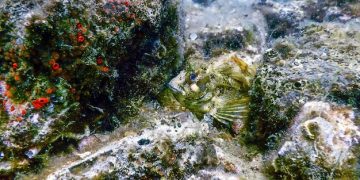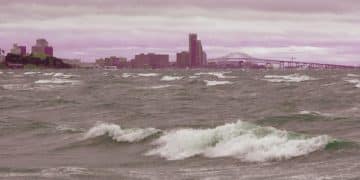Coastal Erosion Accelerating: New Federal Funds for US Coastlines

Coastal erosion threatens US coastlines, but new federal funding aims to bolster protection efforts and community resilience.
The relentless advance of coastal erosion is reshaping America’s shorelines, posing significant threats to infrastructure, ecosystems, and communities. Facing this escalating crisis, new federal funding has become available, offering a lifeline to states and localities striving to protect their vulnerable coastlines.
Understanding Coastal Erosion: A Growing Threat
Coastal erosion is a natural process, but its acceleration due to climate change and human activities is causing significant concern. Higher sea levels, increased storm intensity, and altered sediment patterns are all contributing to the rapid loss of valuable coastal land. The consequences are far-reaching, impacting property values, tourism, and the overall health of coastal ecosystems.
Factors Contributing to Accelerated Erosion
Several factors are exacerbating coastal erosion in the United States. These include:
- Sea Level Rise: As global temperatures rise, melting glaciers and thermal expansion of water cause sea levels to increase, inundating low-lying areas and accelerating erosion.
- Increased Storm Intensity: More frequent and intense storms, fueled by climate change, generate powerful waves that batter coastlines, causing significant erosion.
- Human Development: Construction of seawalls, jetties, and other coastal structures can disrupt natural sediment transport, leading to increased erosion in adjacent areas.
- Deforestation: Removal of coastal vegetation, such as mangroves and dunes, weakens natural defenses against erosion.

The Impact on Coastal Communities
The impact of coastal erosion extends beyond environmental concerns, affecting the livelihoods and well-being of coastal communities. Homes and businesses are at risk of being damaged or destroyed, leading to economic losses and displacement. Additionally, the loss of beaches and recreational areas can negatively impact tourism, a vital industry for many coastal states.
Coastal erosion poses a major threat to both the environment and the economy. As climate change continues to worsen its effects, understanding and addressing this problem becomes even more critical for protecting vulnerable coastlines and communities in the US.
New Federal Funding Initiatives: A Ray of Hope
Recognizing the urgency of the situation, the federal government has launched several funding initiatives aimed at supporting coastal erosion mitigation and resilience efforts. These programs provide financial assistance to state and local governments, as well as non-profit organizations, to implement projects that protect coastlines and enhance community preparedness.
Infrastructure Investment and Jobs Act (IIJA)
The IIJA, signed into law in 2021, allocates significant funding to address coastal erosion and climate resilience. The Act includes provisions for projects such as:
- Beach Nourishment: Replenishing eroded beaches with sand to provide a buffer against storm surges and wave action.
- Dune Restoration: Rebuilding and strengthening coastal dunes to protect inland areas from flooding and erosion.
- Living Shorelines: Implementing natural solutions, such as oyster reefs and mangrove plantings, to stabilize shorelines and enhance habitat.
- Infrastructure Improvements: Upgrading or relocating critical infrastructure, such as roads and water treatment plants, away from vulnerable coastal areas.
National Oceanic and Atmospheric Administration (NOAA) Programs
NOAA offers a variety of grant programs that support coastal management and resilience efforts. These programs include:
- Coastal Zone Management Program (CZMP): Provides funding to states to develop and implement coastal management plans that address erosion, sea level rise, and other coastal hazards.
- National Coastal Resilience Fund (NCRF): Supports projects that enhance the resilience of coastal communities to the impacts of climate change.
- Community Rating System (CRS): A voluntary program that incentivizes communities to adopt floodplain management practices that reduce flood risk and lower insurance premiums.
Federal funding initiatives will play a crucial role in bolstering coastal resilience and protecting communities from the devastating impacts of erosion.
Eligibility and Application Process
Securing federal funding for coastal erosion projects requires a thorough understanding of eligibility requirements and the application process. Each funding program has its own specific criteria, which may vary based on project type, location, and applicant qualifications. It is essential to carefully review the guidelines and ensure that all requirements are met before submitting an application.
Identifying Eligible Projects
Generally, eligible projects must demonstrate a clear benefit to coastal communities and ecosystems. Priority is often given to projects that:
- Address critical erosion problems.
- Promote sustainable solutions.
- Involve community engagement.
- Leverage partnerships.
Navigating the Application Process
The application process typically involves several steps, including:
- Submitting a preliminary application or letter of intent.
- Developing a detailed project proposal.
- Providing supporting documentation, such as environmental assessments and engineering plans.
- Participating in a review process.
Understanding the eligibility and application process is paramount for accessing federal resources to combat coastal erosion and protect vulnerable coastlines.
Case Studies: Successful Coastal Erosion Mitigation Projects
Examining successful coastal erosion mitigation projects can provide valuable insights and inspiration for communities seeking to protect their shorelines. These case studies demonstrate the effectiveness of various strategies and highlight the importance of careful planning and community involvement.
Beach Nourishment in Miami Beach, Florida
Miami Beach has implemented an ongoing beach nourishment program to combat erosion and maintain its world-famous beaches. The project involves periodically replenishing the beach with sand dredged from offshore sources. This has provided a buffer against storm surges, protecting hotels and other beachfront properties.
Living Shorelines in the Chesapeake Bay
Living shorelines projects are gaining popularity in the Chesapeake Bay region as a sustainable alternative to traditional hard structures. These projects use natural materials, such as oyster reefs and native plants, to stabilize shorelines and enhance habitat. They offer a cost-effective and environmentally friendly way to reduce erosion.

Dune Restoration in North Carolina
North Carolina has invested heavily in dune restoration projects to protect its barrier islands from erosion. These projects involve planting native grasses and installing sand fences to trap windblown sand and build up dunes. The restored dunes provide a natural barrier against storm surges, protecting inland communities.
These examples highlight the value of proactive planning and community engagement in the design of successful projects, which helps stakeholders learn from past experiences and implement effective strategies in their own areas.
The Role of Technology in Coastal Erosion Monitoring
Advancements in technology are playing an increasingly important role in monitoring coastal erosion and informing management decisions. Remote sensing, GPS, and computer modeling are providing valuable data and insights that can help communities better understand and respond to the challenges of coastal erosion.
Remote Sensing and GIS
Remote sensing technologies, such as aerial photography and satellite imagery, can be used to track changes in coastlines over time. Geographic Information Systems (GIS) can then be used to analyze this data and create maps that show areas of erosion and vulnerability. This information can be used to prioritize areas for protection and to monitor the effectiveness of mitigation efforts.
GPS and LiDAR
GPS technology can be used to precisely measure the elevation and position of coastal features, such as beaches and dunes. LiDAR (Light Detection and Ranging) is another technology that uses laser scanners to create detailed topographic maps of coastal areas. This information can be used to track changes in beach profiles and to assess the impact of storms and other events on coastal landforms.
Computer Modeling
Computer models can be used to simulate the effects of sea level rise, storm surges, and other factors on coastal erosion. These models can help communities to predict future erosion rates and to evaluate the effectiveness of different mitigation strategies. They can also be used to develop early warning systems for coastal hazards.
Technology is revolutionizing the way we monitor and manage coastal erosion, providing valuable tools for protecting vulnerable shorelines and communities.
Community Engagement and Long-Term Planning
Effective coastal erosion management requires strong community engagement and long-term planning. It is essential to involve all stakeholders, including property owners, businesses, and community leaders, in the decision-making process. This ensures that projects are aligned with community needs and values, and that resources are used effectively.
Developing a Coastal Management Plan
A comprehensive coastal management plan should include:
- An assessment of coastal hazards and vulnerabilities.
- Goals and objectives for coastal protection and resilience.
- Strategies for mitigating erosion, managing development, and protecting ecosystems.
- A plan for community engagement and education.
- A framework for monitoring and evaluating the effectiveness of management actions.
Building Partnerships
Coastal erosion management often requires collaboration among multiple agencies and organizations. Building partnerships among federal, state, and local governments, as well as non-profit organizations and private landowners, can help to leverage resources and expertise. These partnerships can also help to ensure that management actions are coordinated and effective.
Engaging the community and thinking long-term are key steps to ensuring resources are aimed to protect coasts effectively.
| Key Point | Brief Description |
|---|---|
| 🌊 Coastal Erosion | Threatens US coastlines due to climate change and human activities. |
| 💰 Federal Funding | New initiatives aim to support mitigation and resilience efforts. |
| 🛠️ Mitigation Projects | Include beach nourishment, dune restoration, and living shorelines. |
| 🤝 Community Engagement | Essential for effective coastal management and long-term planning. |
Frequently Asked Questions
▼
Coastal erosion is the wearing away of land and removal of sediments along the coastline by wave action, tidal currents, or drainage. It is a problem because it threatens infrastructure, ecosystems, and coastal communities, leading to economic losses and displacement.
▼
Federal funding initiatives support a wide range of projects, including beach nourishment, dune restoration, living shorelines, and infrastructure improvements. These projects aim to protect coastlines, enhance community resilience, and promote sustainable solutions.
▼
Communities can apply by carefully reviewing the guidelines and requirements of each funding program. The application process typically involves submitting a preliminary application, developing a detailed project proposal, and providing supporting documentation.
▼
Technology plays a crucial role in monitoring coastal erosion by providing valuable data and insights. Remote sensing, GPS, LiDAR, and computer modeling are used to track changes in coastlines and assess the impact of storms and other events.
▼
Community engagement is essential because it ensures that projects are aligned with community needs and values and that resources are used effectively. It involves stakeholders in the decision-making process, promoting sustainable solutions.
Conclusion
The acceleration of coastal erosion presents a formidable challenge to the United States, demanding urgent action to protect vulnerable coastlines and communities. New federal funding initiatives offer a vital opportunity to implement effective mitigation strategies, enhance resilience, and safeguard the economic and environmental well-being of coastal regions for generations to come. Through careful planning, community engagement, and technological innovation, it is possible to navigate the challenges of coastal erosion and build a more sustainable future for America’s shores.





